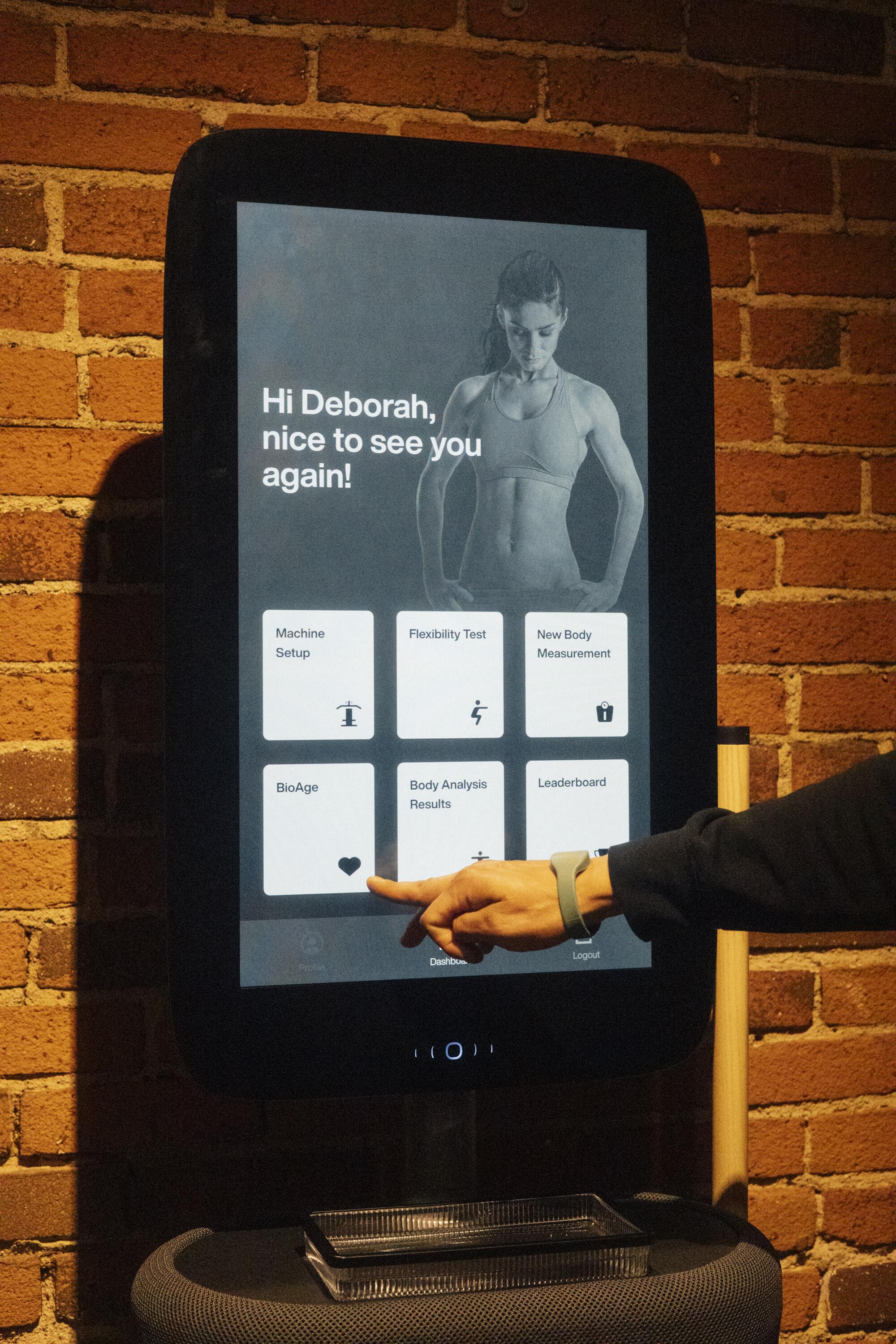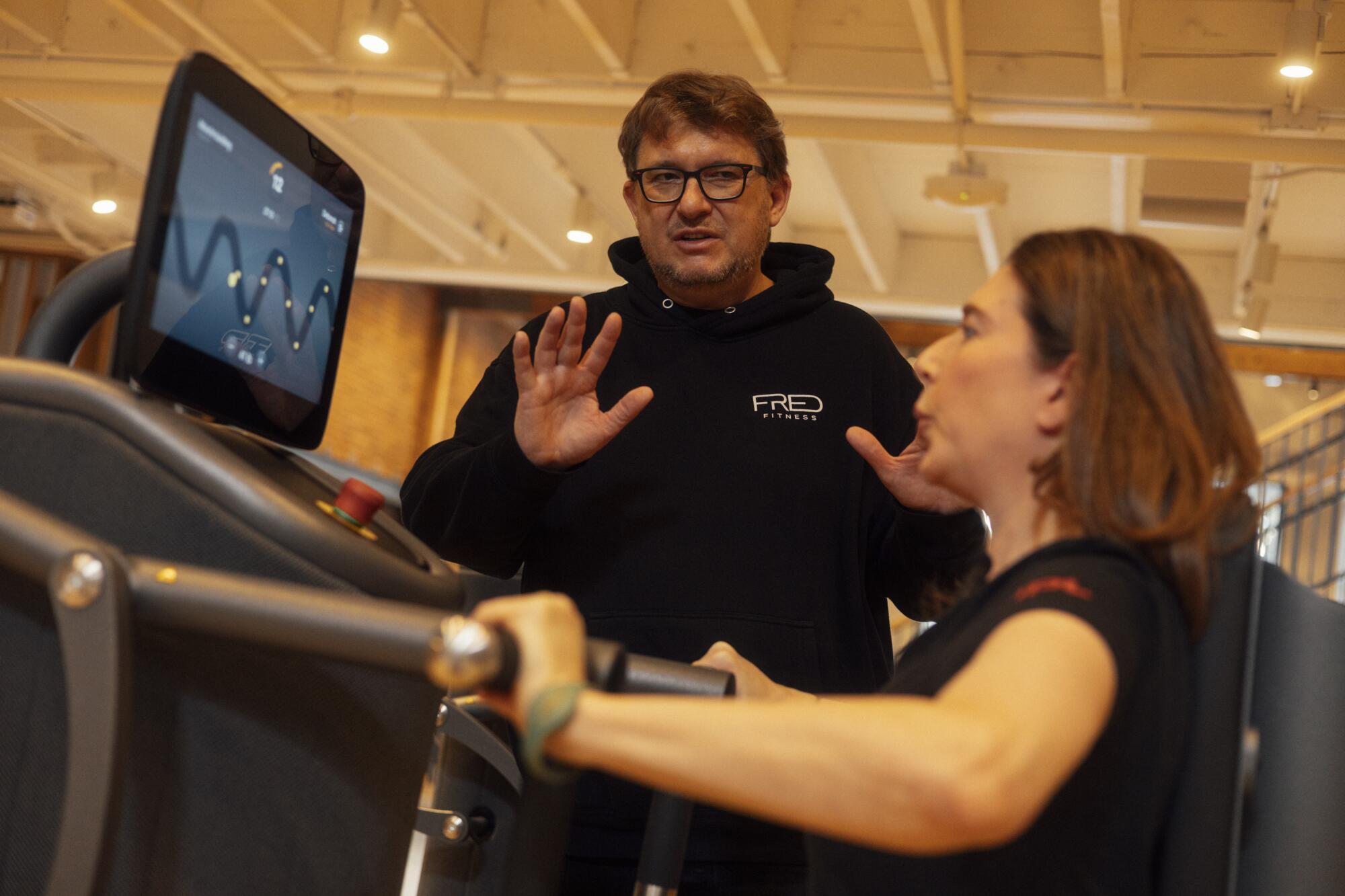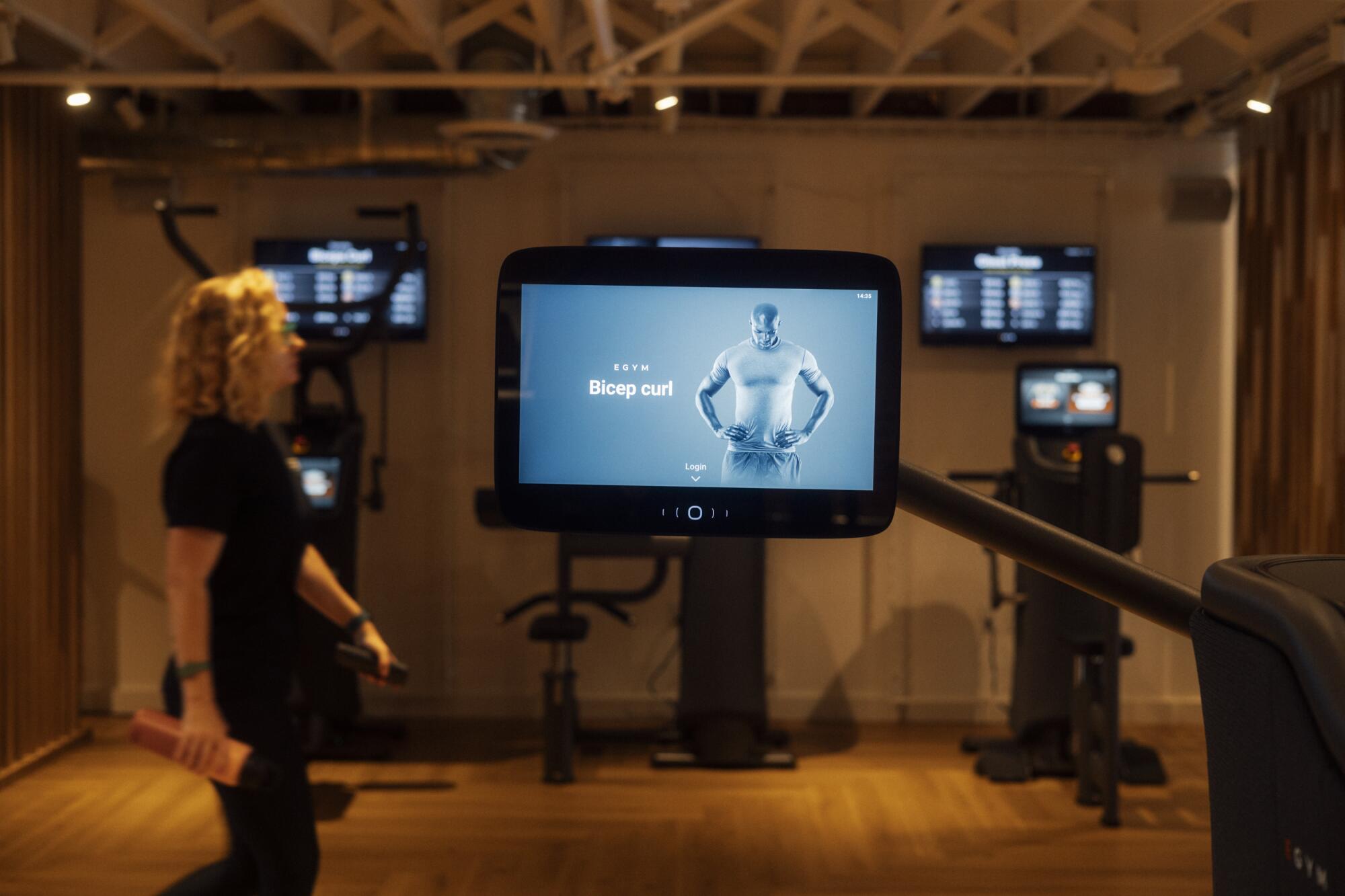The genius knows all. It knows my height, my weight, my hydration, my cardio stamina — even, regrettably, my body’s visceral fat percentage. I’m standing on a bioelectrical impedance device — which looks a lot like a scale but with metal handles and metal foot pads — and it’s sending low-grade, painless electrical signals through my hands and feet to measure my muscle, fat and water. The percentages of each are then fed into an AI program.
Welcome to Fred Fitness, which touts itself as L.A.’s “first full-scale AI-powered gym.” You might be wondering: What does that even mean? Mostly that AI-powered software, referred to as Genius, is integrated into every piece of cardio and strength equipment at the gym. Throughout your workout, it functions as an ever-present but imperceptible force, sparking beneath the surface, like a digital mycelium network with an agenda: to help you reach your training goal (whether that’s weight loss, strength building or toning) in the most efficient way possible.
The Santa Monica facility opened in mid-February in an 11,500-square-foot former Patagonia store on 4th Street. Fred Fitness CEO Andre Enzensberger says the gym has about 400 members, who pay $150 a month to be bossed around by an algorithm.
Inside Fred Fitnessm an AI gym in Santa Monica.
(Chiara Alexa / For The Times)
At first glance, Fred Fitness looks like nothing more than a high-end gym in a tony neighborhood. It’s airy and bright, with soaring ceilings, exposed wood rafters and leafy hanging plants. On a recent Wednesday afternoon, it was sparsely populated, with just a few dozen members working out on brand-new, still-gleaming treadmills, bikes and elliptical machines. The strength machines use electric motors to create resistance instead of physical weights, so there’s no clanking. It’s relatively quiet but for the whirring of cardio equipment and a blend of lo-fi and electronic pop music on the sound system. Not exactly “The Matrix.”
But the exercise machines at Fred Fitness are tailored to you. They know members’ names and body analysis data, and they’ve configured personalized workout programs customized to their goals and fitness abilities. They’re also gamified, meaning their screens display a “Pac-Man”-like video game that members “play” by moving the weight during reps and sets. Grab the handles of a seated rowing machine, for example, and pull the weight faster or slower to move your on-screen avatar — a ball — up or down within a maze and “eat” coins as you go. Competitive? The gym keeps track of your scores, if you choose to participate, and displays the information on an app and a wall-mounted monitor to encourage a sense of community.

Fred Fitness an AI gym in Santa Monica.
(Chiara Alexa / For The Times)
“I love it because it’s fun and totally automated,” says Keverton Marinho, a 32-year-old new member. “I just play — I don’t have to think about anything.”
The gamification may be fun, but it’s purposeful too, Enzensberger says.
“It helps members train at the correct speed,” he says. “It regulates time under tension, meaning how fast you push or how slow you release the weight. So your workout is more effective.”
-
Share via
There’s no joining fee at Fred Fitness and the month-to-month membership includes access to certified personal trainers — though not unlimited sessions — who consult with members about their AI-generated training programs. Trainers also wander the gym floor, answering questions and offering corrections when they notice someone’s form is off. That human element is critical, Enzensberger says.
“AI is so big right now, but we’re very proud of the human aspect of our gym — the team — and how we complement the AI precision,” he said.
Before joining, potential members undergo a free full-body assessment from Genius to get a fitness baseline. A “body composition analyzer” breaks down fat and lean muscle mass limb by limb and gives stats about foundational muscle strength, base metabolic rate and hydration levels, among other metrics. That information is then interpreted by the AI. Many gyms offer fitness assessments when you sign up for personal training, and luxury health clubs, such as Equinox and Santa Monica’s Love Life, do in-depth health and fitness testing for new members; but most regular gym memberships don’t include fitness assessments.
After the body composition analysis, which measures your metabolism, a human trainer leads the member-to-be through different exercise circuits on machines that measure their strength, cardio and flexibility. There’s also a series of on-screen questions related to workout goals, exercise experience and preferences.
Genius then assigns the member a “biological age” — different from your chronological age in years. It’s like an overall fitness score, says Fred Fitness general manager Miguel Alvino.

Fred Fitness an AI gym in Santa Monica.
(Chiara Alexa / For The Times)
“It’s a metric we use to give people an idea of where their strength and areas of improvement are compared to their calendar age,” Alvino explains.
From that point on, when you log onto an exercise machine with your wristband, it calls up your personalized training program. The machine then physically adjusts to your height and limb length, raising or lowering its seat and altering the position of its handles according to your body. The AI is also adaptive, utilizing machine learning. So it will evolve with you as you get fitter.
“The machines continue to learn about your capabilities,” Enzensberger says. “And that data is collected and fed into the AI to constantly generate a better training program for you.”
Fred Fitness is the brain child of Andre Enzensberger’s brother, Alfred, who is the president and founder of Munich-based Clever Fit, a fitness franchise with more than 500 locations throughout Europe. Alfred Enzensberger partnered with Philipp Roesch-Schlanderer, CEO of EGYM, a global fitness technology company also based in Munich, in 2023 to create a full AI gym. EGYM wrote Genius, which was deployed in August 2024. They brought in Andre Enzensberger as CEO.

Fred Fitness an AI gym in Santa Monica.
(Chiara Alexa / For The Times)
There are other gyms with smart or AI-powered equipment in Southern California, such as L.A.’s EōS Fitness (with equipment from EGYM) and Smart Fit Method in Orange County. But at Fred Fitness, “Every piece of machinery is tied into the network,” Andre Enzensberger says. “We’re utilizing what the AI system can do on a much larger, fuller scale.”
Los Angeles was the ideal city in which to launch the venture, given its history as a hub for fitness and tech culture, he says. “We wanted to embrace the open-mindedness of the people of Los Angeles. Fred Fitness is groundbreaking and requires people who want to experience training in a new way.”
I enjoyed Genius’ guidance during my workout. The treadmill set itself to a lower speed than I normally run at, though at a higher incline, because Genius knew my exercise goal was strength building, not weight loss. And I loved the gamification element of the weight-lifting machines, even going so far as to laugh out loud mid-rep — though I wonder whether the game would get old over time. But in the end, what keeps me coming back to a gym is the promise of a sauna or steam after my workout. And Fred Fitness, unfortunately, doesn’t provide those amenities, which was disappointing.
But growth is on the horizon. A second Fred Fitness is now underway in downtown Culver City — it’s planning to open in early 2026 — and the company hopes to open four additional facilities within three to five years. The locations under consideration are downtown L.A., West Hollywood and Glendale.
“This is just a modern gym that’s fun to use — and people love it because it takes the guesswork out,” Enzensberger says. “Everything is fully guided.”
This story originally appeared on LA Times


